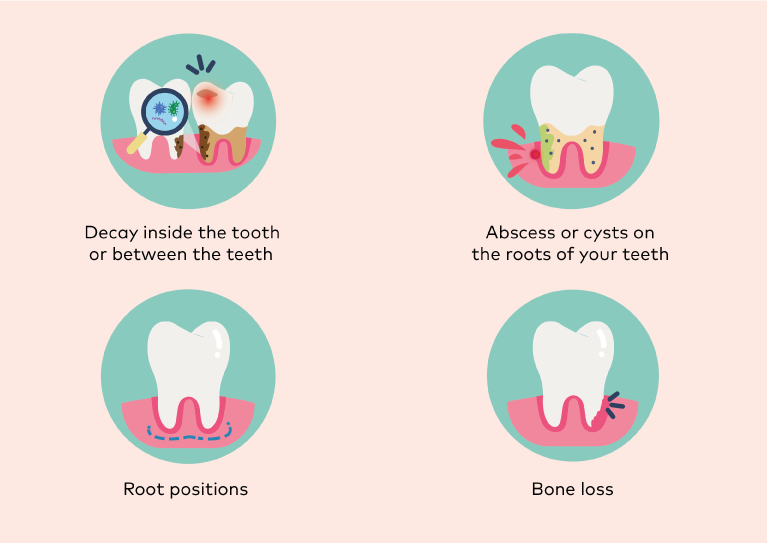All you need to know about digital and 3D cone beam x-rays
Our doctors employ state-of-the-art technology to enhance our patients’ experience. We use one of the latest digital X-ray systems – SIRONA ORTHOPHOS XG 5 and VISTASCAN for precise and rapid investigation for a single tooth or full mouth format using a minimum dose of radiation.
Dental X-rays (radiographs) are images of your teeth that your dentist uses to evaluate your oral health. These X-rays are used with low radiation levels to capture images of the interior of your teeth and gums. This process can help your dentist identify problems, like cavities, tooth decay, and impacted teeth.
Dental X-rays may seem complicated, but they’re prevalent tools that are just as important as your teeth cleanings.
Potential risks of dental X-rays
While dental X-rays involve radiation, the exposure levels are so low that they’re usually considered safe for children and adults. If your dentist uses digital X-rays instead of developing them on film, your radiation exposure risks are even lower.
Pregnancy is an exception to the rule. Women who are pregnant or believe they may be pregnant should avoid all types of X-rays. Inform your dentist if you are pregnant as radiation is not considered safe for developing fetuses.
How do I know I need this treatment?
Localised 2D dental X-rays may be taken to check for:

On the other hand, 2D panoramic (full-mouth) X-rays show a broad view of the jaws, teeth, sinuses, nasal area, and temporomandibular (jaw) joints. These X-rays show impacted teeth (e.g. wisdom tooth), bone abnormalities, cysts, solid growths (tumours), infections, and fractures.
When necessary, our doctors may recommend the patient take a 3D X-ray for better prosthetic and surgical planning, especially for implant treatment.
How digital and 3D cone beam X-rays are done at DP Dental
Dental X-rays require no special preparation. The radiation exposure is so low that no lead vest is required for this procedure. In the X-ray room, the X-ray machine is positioned alongside your head to record images of your mouth, and the process takes less than 30 seconds.
Important points to take note of
A digital X-ray allows the dentist to image the tooth or teeth and put it into an imaging program. Within this imaging program, several tools will enable the dentist to examine the teeth and surrounding structures with outstanding accuracy closely.
As a benefit to the patient, the digital X-ray also provides nearly 80% less radiation than a standard X-ray. This result is because the X-ray’s digital version is much more sensitive to the radiation and has been specifically designed with the patient in mind.
3d cone beam imaging technology – the next generation of dental X-rays
Cone beam imaging is one of the most significant breakthroughs in dental radiology and has proven effective for a wide range of care and treatment applications.
Commonly known as 3D X-ray, cone beam imaging allows our doctors to see bone thickness, jaw structures, tooth relationships and root canal anatomy. They are becoming the standard of care for implant surgery since it shows the relationship between the available bone and significant structures such as nerves and sinuses.
It’s indispensable for making sure that a dental implant does not impinge on the nerve that controls the lower lip. It can also help find some hidden bone around the sinuses allowing for placement without expensive bone grafts.
In teeth alignment treatment, doctors can quickly determine the relationship between the upper and lower jaw in conjunction with the rest of the skull these X-rays. The 3D view can help a dentist search for an elusive root canal or an extremely curved root.
Answering your frequently asked questions
Exactly how much radiation will I be exposed to during X-rays?
With the technological advances in dental X-rays in recent years, the exposure of localized or full-mouth digital X-ray has been reduced to that of normal cosmic exposure. I.e, if you fly from Singapore to HongKong, the amount of radiation you experience will be the same as that of a full-mouth X-ray.
What if another dentist has already taken X-rays for me?
Please bring a clear print or digital copy from the other dental clinic; most clinics will provide you with a copy upon request. We may not need new X-rays, or we may only need to take partial X-rays to bring you up-to-date.
Can I take X-rays when I’m pregnant?
Congratulations on the new member-to-be in your family!
If you already know you are pregnant, or amid some family-planning, do let our doctors know of your plans. Even though the radiation dosages are minimal, the doctors at our clinic do not take X-rays for pregnant mothers.
Can I have a copy of my X-ray?
Absolutely! Just let your doctor know that you wish to have a copy of your X-ray, and we will gladly email a digital version to you.
Reference: healthline.com
